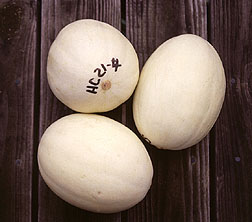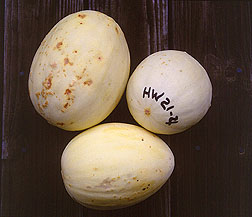Melons Are on a Roll
|
|
Thanks partly to modern international shipping and handling, fresh melons are no longer just seasonal delights. They can now be eaten year round—and Agricultural Research Service studies to improve their postharvest care may increase their appeal even more.
Scientists at the ARS Subtropical Agricultural Research Center in Weslaco, Texas, and at the Children's Nutrition Research Center in Houston, Texas, have worked out a way to extend the market life of melons. They give them a soaking in a special calcium solution during the time it takes to cool them right after harvest.
The dunking could allow growers to provide sweet and tasty, vine-ripened melons in greater quantities and to more distant markets.
In laboratory and preliminary field tests, the treatment prolonged market life by at least 2 weeks. It also increased calcium levels in the melons, especially honeydews. Even without the treatment, honeydews and cantaloupes are rich sources of calcium, with a 1-cup serving providing about 10 percent of an adult's daily calcium needs.
But today's sweeter and more nutritious varieties could become even better as shippers adopt these new postharvest handling procedures.
Could consumption of melons consequently reach new highs? In 1997, per capita consumption of cantaloupes, or muskmelons, rose to 11.7 pounds, eclipsing the 11.2-pound record of 1946. Together, all types of melons rank second to bananas as the most-consumed fresh fruit in the United States.
Why'd They Do It?
This melon research started with plant physiologists Gene E. Lester at Weslaco and Michael A. Grusak at Houston.
Previously, Grusak had developed techniques for studying movement of calcium from roots to edible portions of vegetable plants, a first step toward determining calcium bioavailability. Lester had just completed a study in which he found that certain calcium solutions reduced tissue aging. So Lester, whose primary research is aimed at extending the shelf life of fruit in export markets, asked Grusak to help him develop a way to increase calcium in whole honeydew and cantaloupe melons after harvest.
Lester knew that, just as people need calcium for strong bones, aging melons—especially the tissue associated with the rind—need calcium to maintain a degree of firmness that protects against spoilage. But in ripe melons, calcium steadily migrates from the rind to the seeds, depleting the rind of calcium needed for maintaining cellular functions.
Before the scientists began work on a treatment for whole melons, they had to get an idea of calcium concentrations that might work best. Grusak started by first analyzing portions of melons, to learn where calcium and magnesium occur naturally.
|
|
Then, Lester grew honeydews and cantaloupes in a greenhouse and submerged whole fruits in solutions of calcium chelated, or ringed, with amino acid molecules, as well as in non-calcium control solutions. He then cut the fruits into millimeter sections, from the rind to the seed cavity, and dried them for shipment to Grusak's lab. Grusak measured how much calcium was in each section and then profiled how much calcium had migrated through the melon layers.
"We did between 200 and 300 samples," says Grusak.
"The calcium had a much stronger effect in the honeydews than in cantaloupes, and we think that may be because of the cantaloupe's thick, spaghetti-like outer netting."
In cantaloupes, about 10 days after the fruit begins to form, tissue technically known as "lenticular" starts to crack through the outer rind to develop the irregular netting. Honeydews, on the other hand, generally have no webbing and thus convey calcium efficiently through a normally unbroken skin into the all-important adjacent green layer of the outer rind. To confirm that cantaloupes' lenticular tissue was a problem, Grusak treated small areas of whole melon surfaces with the solution, but this time he labeled the calcium with radioisotopes. This allowed him to trace the nutrient's path through the fruit. Using the radioisotopes, he confirmed that the calcium moved more quickly through the honeydew than through the cantaloupe. In this experiment, the scientists treated freshly harvested melons for 20 minutes in a 40-millimolar calcium solution (1.6 grams of calcium per liter) chelated with amino acid. Within 24 hours, labeled calcium in honeydew rind tissue measured about 24 percent of the labeled calcium that was applied. In cantaloupes, when the radioisotope was applied directly onto the lenticular tissue, the amount of labeled calcium was less and variable—9 to 12 percent.
The shelf life of vine-ripened honeydew and cantaloupe is generally about 7 to 12 days. Increased calcium in treated greenhouse-grown honeydews at least doubled their shelf life, Lester says.
The scientists found an application of amino acid-calcium chelate solution with at least 80 millimolar calcium (3.2 grams per liter) was needed to appreciably extend the shelf life of whole honeydews or cantaloupes grown in the greenhouse. Up to 100-millimolar solutions are now included in experiments begun last spring with field-grown melons, which tend to have thicker rinds.
"We want to find concentrations of calcium that work best without harming spring- and fall-grown melons, because too much calcium can be toxic to the melon," says Lester.
Already the research has led to industry interest. A major U.S. melon grower-shipper, Starr Produce Co. of Rio Grande City, Texas, is providing vine-ripened melons for the research. According to David LaGrange, manager of the company's LaCasita Farms, vine-ripened honeydews are really delicious but more difficult to ship than those harvested as little as 3 days sooner. He says the calcium treatment may help pave the way for extensive marketing of vine-ripened melons.
By planting recently developed hybrid honeydews and harvesting them at full maturity, growers could easily comply with the federal law stipulating that melons destined for interstate commerce can be harvested when their soluble solids content reaches 9 percent. Hybrid melons detach themselves from the vine when ripe, and as they do, the soluble solids typically range from 12 to 15 percent—almost totally in the form of sugars.
Melons treated to slow down softening could be shipped by surface transportation, rather than flown, halfway around the world. Very sweet, unblemished, green-fleshed melons have proven themselves popular, especially in Japan.—By Ben Hardin and Jill Lee, Agricultural Research Service Information Staff.
Gene E. Lester is in the USDA-ARS Crop Quality and Fruit Insect Research Unit, Kika de la Garza Subtropical Agricultural Research Center, 2301 S. International Blvd., Weslaco, TX 78596; phone (956) 565-2647, fax (956) 565-6652.
Michael A. Grusak is at the USDA-ARS Children's Nutrition Research Center, 1100 Bates St., Houston, TX 77030; phone (713) 798-7044, fax (713) 798-7078.
"Melons Are on a Roll" was published in the February 1999 issue of Agricultural Research magazine.








